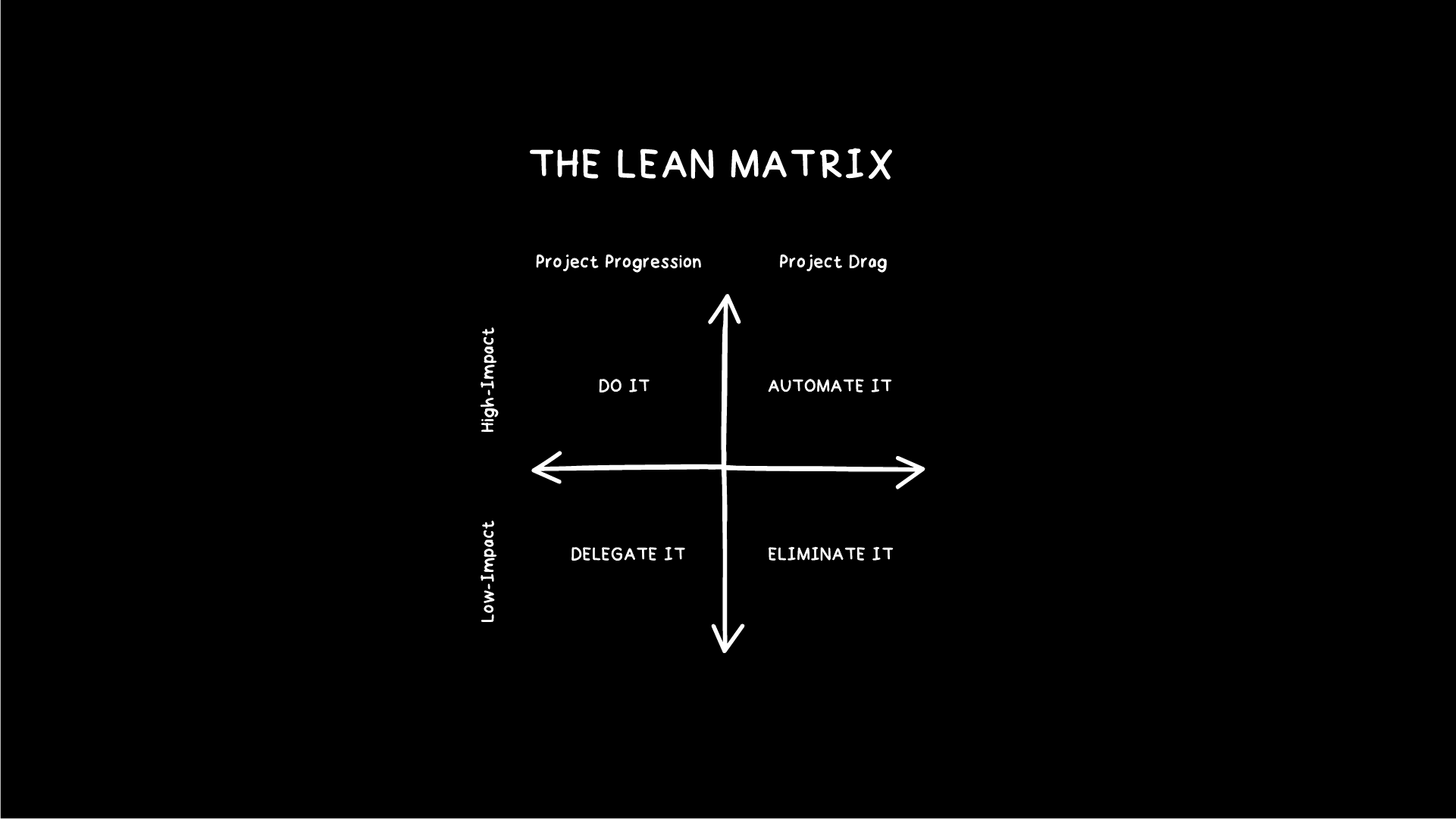The Lean Matrix: A Smarter Way to Manage Your Logo Design Projects
Managing a logo project involves many moving parts—from initial client discussions and research to ideation, execution, and final presentation.
If you’ve ever felt overwhelmed by the sheer amount of work involved, you’re not alone.
Many designers end up spending hours on tasks that don’t actually move the project forward, leading to inefficiencies, burnout, and wasted effort.
After nearly a decade of designing logos and identity systems across freelance, in-house, and agency roles, I’ve reflected on my most impactful projects.
Some parts of a logo design project are essential, and some should be prioritized, while others can be automated, delegated, or even eliminated to streamline the workflow.
This is where The Lean Matrix comes in. Inspired by efficiency principles, this matrix helps designers categorize tasks based on their impact on the project and whether they drive progress or cause unnecessary bottlenecks.
In this post, I'll break down The Lean Matrix and show you how to use it to make better decisions in your logo and identity design projects.
Key Takeaways
Learn how to categorize tasks into Do It, Automate It, Delegate It, or Eliminate It.
Discover which tasks drive project progression and which ones become project drags.
Understand how to work smarter and spend energy on high-impact areas.
The Lean Matrix Explained
The Lean Matrix is built on two key variables:
High Impact vs. Low Impact → Does this task contribute significantly to the success of the project?
Project Progression vs. Project Drags → Does this task move the project forward or slow it down?
Heavilly inspired by The Eisenhower Decision Matrix, The Lean Logo Matrix is adjusted specifically for logo designers.
Built on four quadrants, helping you determine how to handle different aspects of a logo project:
The Lean Matrix
DO IT → The high-impact creative work you should do
This quadrant is where your expertise and problem-solving abilities shine.
These are the tasks that require your strategic thinking, creativity, and unique skill set.
These are essential tasks that require your expertise.
Examples: Brand strategy, core logo design ideation, presenting the logo.
These are the tasks that make you valuable as a designer. This is where your time should be spent the most.
AUTOMATE IT → Tasks that AI & software can handle
There are many aspects of logo design that don’t require manual effort anymore, but are important within a logo project.
Automation tools can help you speed up repetitive tasks so you can focus more on High-value Tasks, that requires your effort:
Important but time-consuming tasks that can be streamlined.
Examples: Grid systems, alignment tools, AI-assisted ideation. Check out my blog about top AI & Automation apps logo designers should use here.
Automating these tasks doesn’t reduce your value—it frees up your time so you can spend it on higher-value design decisions.
DELEGATE IT → Tasks others can take off your plate
If a task doesn’t require your personal expertise, it may be worth delegating.
This is especially useful for freelancers who want to scale their business or agency teams looking to optimize workflow.
Tasks that move the project forward but don’t require your direct involvement.
Examples: Admin work, research, file preparation, motion graphics.
I would even argue that you should outsource some logo design projects. This can be best for the client and you as the designer. This is a discussion for a future topic…
Delegating doesn’t mean losing control—it means focusing on what moves the needle most.
ELIMINATE IT → Time-wasters that don’t bring real value
Not every task in a logo project is necessary.
Some are habits picked up over time that add little value and should be eliminated altogether.
Tasks that provide little to no value and should be removed.
Examples: Over-exploring weak concepts, excessive pixel pushing, unnecessary revisions.
If a task doesn’t serve a real purpose, it’s time to cut it out.
My Prediction on the Future of Logo Design
The design industry is evolving rapidly, and more tasks will shift into the Automate and Delegate quadrants thanks to technology.
I believe within the next 5 years:
90% of tasks in the Do It quadrant will shift to Automate It, thanks to AI and smarter workflows.
70% of tasks in Delegate It will move into Automate It, as automation becomes the standard.
95% of tasks in Eliminate It will become obsolete, as designers recognize and cut wasteful efforts.
Industry leaders like Adobe are already adapting to this shift, pushing many repetitive tasks into automation.
The designers who embrace efficiency now will stay ahead as the industry transforms.
Why The Lean Matrix Works for Logo Designers
The Lean Matrix isn’t just about working faster—it’s about working smarter.
By using this framework, designers:
Saves Time & Energy – Focus on what truly matters instead of wasting effort on low-impact tasks.
Reduces Overwhelm – Gives a clear framework for decision-making.
Increases Efficiency – Moves you away from unnecessary bottlenecks and toward smarter workflows.
Future-Proofs Your Process – Adapts to automation and new industry standards.
Conclusion
The world is moving faster, and so should the logo design world.
As technology advances and design expectations evolve, we need to adapt by optimizing our workflows, eliminating inefficiencies, and focusing on what truly matters.
By applying The Lean Logo Matrix, you can stop wasting time on low-value tasks, improve your efficiency, and ultimately deliver better work with less stress.
What’s one design task you think should be automated?

